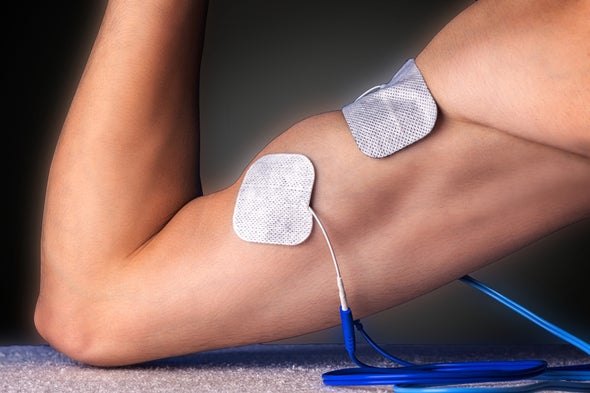Electrical Muscle Stimulation (EMS), also known as neuromuscular electrical stimulation (NMES) or electromyostimulation, is a protocol that elicits a muscle contraction using electrical impulses that directly stimulate your motor neurons. An EMS unit (like a Powerdot, Compex, Tone-A-Matic, or MarcPro) is a device that delivers this in the comfort of your own home.
This stimulation creates muscle contractions that can be quick and frequent, fast with long pauses, or contractions that are held for several (uncomfortable) seconds or minutes at a time.
Normally, it is your body that fires your muscles by sending electrical impulses from your brain through your central nervous system (CNS). But an EMS device allows you to engage in deep, intense, and complete muscular contractions without actually activating (or stressing) your CNS—not to mention your joints and tendons.
The coolest thing is that your body doesn’t know the difference between a voluntary contraction and an electrically stimulated one. Your (silly) body only recognizes that there is a stimulus and reacts to it accordingly.
If this sounds a little wacky to you, don’t worry—there is science to back this up.
A study published in the Journal of Strength and Conditioning looked into whether or not EMS could help elite athletes gain a performance edge. They concluded that “the analysis shows that trained and elite athletes, despite their already high level of fitness, are able to significantly enhance their level of strength to same extent as is possible with untrained subjects.”
At the conclusion of that study, the researchers stated that “EMS offers a promising alternative to traditional strength training for enhancing the strength parameters and motor abilities in athletes.”
Another study from 2015 titled “Effects of high-frequency current therapy on abdominal obesity in young women: a randomized controlled trial” provides a different example of the effectiveness of EMS. Instead of fitness levels, this study looked into whether EMS could help you lose body fat.
In this study, a group of subjects received 30 minutes of high-frequency current therapy via a series of electrodes placed on their stomachs. The subjects did these sessions three times per week for six weeks. After those six weeks, the researchers measured the subject’s waist circumference, body mass index, subcutaneous fat mass (fat under the skin), and total body fat percentage.
Surprisingly, without modifying their exercise or diet, the EMS did indeed cause significant effects on decreasing waist circumference, abdominal obesity, subcutaneous fat mass, and body fat percentage, leading the researchers to conclude: “The use of the high-frequency current therapy may be beneficial for reducing the levels of abdominal obesity in young women.”
Other studies have shown EMS to be helpful for everything from pain management to helping increase muscle blood flow for warming up prior to performance-related activities.
What Is EMS?
During a normal exercise session, your brain sends signals to your muscles to make them voluntarily contract. With Electrical Muscle Stimulation, it is the electrical impulses sent from a device that causes your muscles to involuntarily contract. These contractions can be quick, long, fluttery, uncomfortably long, and everything in between. It is the contraction type that determines whether the session will result in a better warm up, increases in strength, or better recovery.
Before we move on, I want to clear one thing up: A TENS unit is often mistaken for an EMS unit, but don’t be fooled: they are not the same. TENS is short for “transcutaneous electrical nerve stimulation” and that is a measure of nerve stimulation, not muscle stimulation. Although TENS may seem like an inexpensive alternative to EMS, it really is more of a short-term solution. Like a painkiller or a Band-Aid.
How Does EMS Work?
When you want to perform an EMS session, sticky, rubbery pads are placed on the skin at each end of the skeletal muscle band that you want to stimulate. There are three or four channels (depending on the unit) with lead wires to each pad.
When the session or EMS program starts, very small amounts of electrical current run from one pad to the next and complete a circuit using your muscle tissue as a conduit. The motor neurons found within this circuit are stimulated and they contract. Freaky, right? The current runs at specific frequencies (Hz) and pulse durations (microseconds) depending on the program you choose.
EMS works directly on the muscles, bypassing the body’s own energy conservation system, so there is no limit to the percentage of fiber that can be activated.
Varying the frequencies can change which types of muscle fibers are stimulated. Three ranges of frequencies stimulate three kinds of motor neuron-muscle fiber types—aka the slow, medium, and fast twitch fibers.
I use a device called a Powerdot, and at first, I simply used it for massage and recovery. But lately I have been using it to perform strength and explosive strength training electrical sessions while I catch up on the latest binge-worth content. I have to say, despite my skepticism, I have really been able to poop myself out with these sessions. And once again, science is on my side.
A French study used an EMS device called a Compex to investigate the effect of a 5-week electrostimulation (EMS) training program on muscular strength (quadriceps), kicking velocity, sprint, and vertical jump performance in football players.
20 male soccer players were randomly divided into two training groups:
-
EMS Group: Received EMS on the quadriceps muscles during 5 weeks (3 sessions of 12 minutes per week) and soccer training.
-
Control Group: Only had the soccer training.
The athletes were tested after three weeks and five weeks of training and, at both assessments, the EMS group showed significant improvements in quadriceps muscle strength parameters as well as in ball speed performance. These improvements were not seen in the control group.
So, while an EMS device isn’t going to burn a ton of calories and give you an amazing six-pack while you sit on the couch, it can indeed result in a significant boost in cardiovascular and musculoskeletal fitness.
What Can EMS Be Used For?
Warm-up: Increasing blood flow which raises the temperature of the muscle and allows it to work more effectively and efficiently.
Potentiation: The same way that performing some weight squats immediately before performing a verticle leap test can result in high jumping, using an EMS five to ten minutes before a heavy session can help prepare the muscles.
Strength: This EMS program stimulates the Fast Twitch Type IIb muscle fiber and its creatine phosphate energy delivery system. This trains the muscle fibers to deliver energy anaerobically and generate a great deal more force during efforts that last up to one minute.
Resistance: This program trains the Type IIa fast twitch muscle fibers which can deliver energy both aerobically and anaerobically.
Endurance: This program stimulates the Type I slow twitch muscle fibers which are most used in efforts lasting several minutes to hours.
Recovery: My personal favorite, this use features rapid contractions which squeeze the blood out of the capillary beds and makes room for fresh blood to supply the muscle with the delicious oxygen and nutrients your muscles need to recover.
Massage: Probably the most popular program of all. This program is dedicated to endorphin production. The varying pulses and flutters increase blood flow and circulation to decrease soreness, stiffness, and aches.
3 Ways to Use EMS in Your Fitness Program
1. Exercise + EMS
While most EMS devices discourage you from using them during a workout, you can certainly use it before and after. This can be used as a warm-up and a cool-down or as part of the workout itself.
For instance, you could position the EMS on your pectorals, set to a lower setting (like a massage or recovery program) before you hit the weights. Then do your regular chest workout, immediately followed by a strength program using the EMS. Because the EMS works directly on the muscle fibers, bypassing your body’s natural energy conservation system, this would be a great way to “finish off” the workout.
2. Isometrics + EMS
Combining EMS and Isometrics (holding a muscle in a static pose) is an effective way to increase the amount of lactic acid that builds up in a muscle. And likely due to the fact that it is extremely uncomfortable, this can help you improve your ability to tolerate lactate build up during hard workouts or intense competitions.
To use EMS in this way, begin by getting into an isometric position and then applying the EMS. You could do an isometric Wall Sit with the EMS on your quads or combine EMS with lunge holds, push-up holds, or planks.
3. EMS + Rest
Perhaps you have an injury or maybe you are streaming a great new series about mid-century zombie architects and you still want to get some sort of workout done. Most of the time, I would advise you to simply get the heck up and move your body, do some stretches in front of the TV, or turn it off and get outside to move around. But you just bought a fancy new EMS device so I will cut you some slack.
In a sedentary position, you can use EMS to keep your muscles activated without even lifting a finger (well OK, you need your finger to turn the device on). In addition to working your muscles while you are recovering from an injury (or watching the art deco zombies), you can use an EMS device during long car rides, while you are doing your homework, or even stimulate your leg muscles while working at your standing workstation.
Some EMS Quick and Dirty Tips
-
Train a particular muscle group three times per week. If you train a muscle group once a week, you will detrain between sessions. Twice a week is OK but three is ideal.
-
Wait at least 48 hours between training sessions. Training three times per week will leave 48 hours between two of the sessions and 72 hours before the remaining session. Remember, even though you aren’t “doing the work” the EMS strength programs deliver a training load so recovery is important.
-
Stimulate the muscle groups that will benefit you the most. To be efficient with your time, prioritize the muscle groups that are what we call the “prime movers” for your sport or preferred activity.
If you are still skeptical, remember that this kind of muscular stimulation has been used in physiotherapy clinics and sport doc labs for years, and EMS training is quite safe for the majority of people and uses. Having said that, it is always smart before you try anything new with your body to check in with your doctor first.




